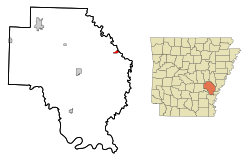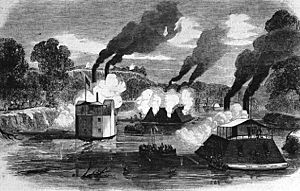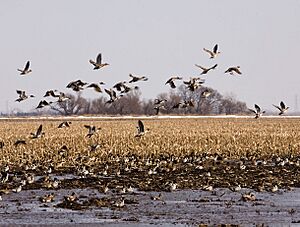St. Charles, Arkansas facts for kids
Quick facts for kids
St. Charles, Arkansas
|
|
|---|---|

Location in Arkansas County and the state of Arkansas
|
|
| Country | United States |
| State | Arkansas |
| County | Arkansas |
| Area | |
| • Total | 0.89 sq mi (2.30 km2) |
| • Land | 0.89 sq mi (2.30 km2) |
| • Water | 0.00 sq mi (0.00 km2) |
| Elevation | 200 ft (60 m) |
| Population
(2020)
|
|
| • Total | 207 |
| • Density | 233.37/sq mi (90.15/km2) |
| Time zone | UTC-6 (Central (CST)) |
| • Summer (DST) | UTC-5 (CDT) |
| ZIP code |
72140
|
| Area code(s) | 870 |
| FIPS code | 05-61940 |
| GNIS feature ID | 2407265 |
St. Charles is a small town in Arkansas County, Arkansas, United States. In 2020, about 207 people lived there. This town has been important in Arkansas's history. St. Charles is famous for the Battle of Saint Charles. This battle happened on the White River, which runs next to the town. St. Charles is also known for being part of the White River National Wildlife Refuge.
Contents
History of St. Charles
Early Days of St. Charles
Long ago, the area where St. Charles is now was home to Native American groups. One of these was the Middle Mississippian culture. Later, the Quapaw people lived here. This was before French explorers arrived in the 1600s.
When American settlers moved into Arkansas, treaties changed things. By 1833, most Quapaw people had left Arkansas. The first European settler in St. Charles was Pierre Pertuis. He was a French fur trader who bought land in 1797.
By 1839, Charles W. Belknap owned the land. It was briefly called Belknap’s Bluff. He built a special adobe house. This house was used as a hospital during the Civil War. It was a well-known building for a long time. The name St. Charles first appeared in 1850. Belknap became the postmaster and started selling land lots. St. Charles grew in the 1850s because of river shipping. Many goods were sent from here.
Civil War and Later Years
St. Charles was the site of a very deadly event during the American Civil War. On June 17, 1862, a battle happened here. Eight Union ships tried to pass Confederate cannons on the White River. A single cannonball hit the USS Mound City gunboat. It went into the ship's steam drum. This caused a huge explosion of hot steam. About 129 crew members died.
After the Civil War, St. Charles faced hard times. The town officially became a town in 1880. It was an important port for shipping goods. This was true until railroads were built. Once trains reached DeWitt, St. Charles became less important for trade.
For many years, the town's economy depended on timber and fishing. Hunting, trapping, and collecting mussels were also important. Mussels were used to make buttons. A school district opened in 1891. The first high school graduation in Arkansas County happened there in 1892.
St. Charles Today
In 1935, the White River area became a wildlife refuge. It was named the White River National Wildlife Refuge. This refuge protects many wetland animals. It also allows hunting for ducks, quail, and pheasants.
St. Charles has seen its population shrink. This is like many other towns in the Delta region. But it has stayed a small town. Many hunters, nature lovers, and birdwatchers visit the White River National Wildlife Refuge.
In 2013, the refuge was named a National Blueway. This means it's a special water path. Later that year, there were plans to make the refuge bigger. They wanted to buy over 100,000 acres of land. This would help protect more wildlife. It would also save the Arkansas "Big Woods." Only about 10% of these old forests are left. In 2014, the refuge was renamed. It is now called the "Dale Bumpers White River National Wildlife Refuge." This honors former Arkansas Governor Dale Bumpers.
| Historical population | |||
|---|---|---|---|
| Census | Pop. | %± | |
| 1880 | 73 | — | |
| 1890 | 128 | 75.3% | |
| 1920 | 200 | — | |
| 1930 | 245 | 22.5% | |
| 1940 | 412 | 68.2% | |
| 1950 | 313 | −24.0% | |
| 1960 | 255 | −18.5% | |
| 1970 | 201 | −21.2% | |
| 1980 | 199 | −1.0% | |
| 1990 | 169 | −15.1% | |
| 2000 | 261 | 54.4% | |
| 2010 | 230 | −11.9% | |
| 2020 | 207 | −10.0% | |
| U.S. Decennial Census | |||
Climate and Weather
The weather in St. Charles has hot, humid summers. Winters are usually mild to cool. This type of weather is called a humid subtropical climate.
Geography of St. Charles
St. Charles covers about 0.89 square miles (2.30 square kilometers). Most of this area is land. A very small part, about 0.01 square miles (0.02 square kilometers), is water.
People of St. Charles
In 2000, there were 261 people living in St. Charles. There were 113 households, which are groups of people living together. About 81 of these were families.
The town had 150 housing units. Most people were White (98.08%). A small number were Black or African American (1.75%). Even fewer were Native American (1.15%). About 0.77% of the people were Hispanic or Latino.
About 23.9% of households had children under 18. Most households (56.6%) were married couples. The average household had 2.31 people. The average family had 2.69 people.
The median age in the town was 45 years old. This means half the people were older than 45 and half were younger. About 17.6% of the people were under 18. About 20.7% were 65 or older.
The median income for a household was $24,375. For families, it was $29,167. About 22.7% of the people lived below the poverty line. This means they had very low incomes.
Education
Students in St. Charles go to schools in the DeWitt School District. This includes DeWitt High School. The St. Charles School District joined the DeWitt district on July 1, 1985.
See also
 In Spanish: Saint Charles (Arkansas) para niños
In Spanish: Saint Charles (Arkansas) para niños



